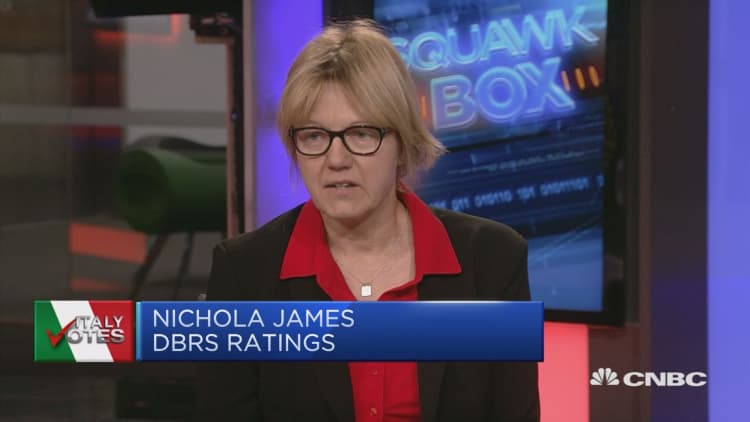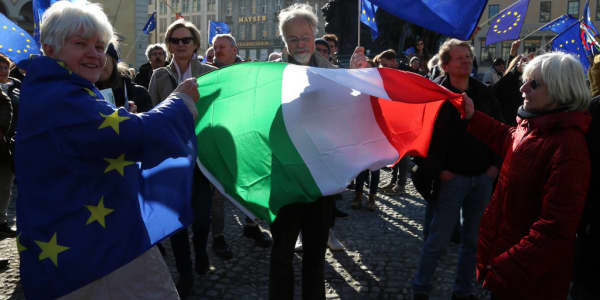Italian voters go to the polls on March 4 in a vote that has some striking similarities to Germany's political scene right now.
When Italians vote Sunday, Germans will be waiting for the outcome of another vote that will determine whether the country finally gets a government, six months after its federal election last September.
The vote that's being closely watched in Germany is the result of a ballot of Social Democratic Party (SPD) members. They are being asked whether they approve of another coalition with Chancellor Angela Merkel's Christian conservative bloc, formed by her Christian Democratic Union party (CDU) and its sister party, the Christian Bavarian Union (CSU).
The ballot comes after Merkel unsuccessfully tried to form a coalition with the Greens and the pro-business Free Democratic Party (FDP). Having initially said it would stay in opposition, following a punishing result in the September election, the SPD eventually agreed to talks with Merkel to end the political uncertainty.
In return for its support, the SPD extracted deep concessions from Merkel's conservative bloc. The majority of SPD members are expected approve the latest coalition deal although there has been vocal criticism of the alliance from within the party.
Hung parliament
Italy and Germany are not countries that could usually be lumped together when it comes to politics. One is known for its disordered political scene (Italy is infamous for having had 65 governments now since World War II) and the other, Germany, for its political order and structure.
But, like Germany, the Italian election is expected to produce a hung parliament where no one party gains a majority, if consistent voter polls are to be borne out in the vote.
Coalition partners
Following reforms to Italy's electoral law that allow coalitions to contest seats in parliament, Italy's main political parties have already formed into center-right and center-left blocs in a bid to make the most of the changes.
The center-right bloc is led by former Prime Minister Silvio Berlusconi, and comprises his Forza Italia party and Noi con l'Italia (both center-right parties), as well as Lega (formerly Lega Nord) and Fratelli d'Italia.
The center-left coalition comprises the ruling Democratic Party (PD) and a number of smaller, left-leaning parties such as pro-European Piu Europa (More Europe) and Insieme (Together).
The anti-establishment 5 Star Movement, in no coalition currently, opposed the reforms to Italy's electoral law and says it is disadvantaged by the new rules.
Rise of the right
Just like Germany which has seen a significant rise in vote share for the Alternative for Germany party — an anti-immigrant, Euroskeptic right-wing party — Italy has seen its own right-wing parties goes mainstream.
Lega and Fratelli d'Italia, which could enter a center-right coalition with Berlusconi, are accused of racist and xenophobic policies by their critics.
With slogans calling for an end to the "invasion" of migrants and "Italians first," it's easy to see why opponents are wary of such parties having a strong influence in government. Yet, with these parties seeing their popularity rise, parties on the center-left like the Democratic Party has also shifted its rhetoric, promising a tougher stance on immigration.
For their part, Lega and Fratelli d'Italia say that the migrant influx to Italy is out of control and that "social conflict" will result. Already, Italy has seen an increase in negative sentiment and even violence towards immigrants with one neo-Nazi shooting where six African migrants were wounded at the start of February.

Immigration
Immigration has been a key topic of the election debate in both Italy and Germany. Both countries have seen a massive increase in the number of migrants and asylum seekers over the past few years. At the height of the migrant crisis in Europe in 2015, Germany said it saw more than 1 million migrants enter the country, most fleeing war in the Middle East or poverty and conflict in Africa.
While thousands of migrants traveled up through Europe in a bid to reach Germany, the region's largest economy, thousands started that journey after disembarking in Italy — the first port of call for most migrants leaving northern Africa.
In 2017, 119,310 migrants arrived in Italy after traveling by sea, according to data released in January from the UN's International Organization for Migration (IOM). The organization recorded that 2,832 people died or went missing making the journey.
While public sentiment was largely sympathetic to the plight of thousands of families fleeing Syria at the height of the civil war, there has been a public backlash in both Germany and Italy at the perceived large number of young, single men leaving their homelands as economic migrants rather than asylum seekers and refugees.
Both Italy and Germany have pledged to deport failed asylum seekers, reflecting a tougher stance amid changing public opinion and the trends towards the right.





